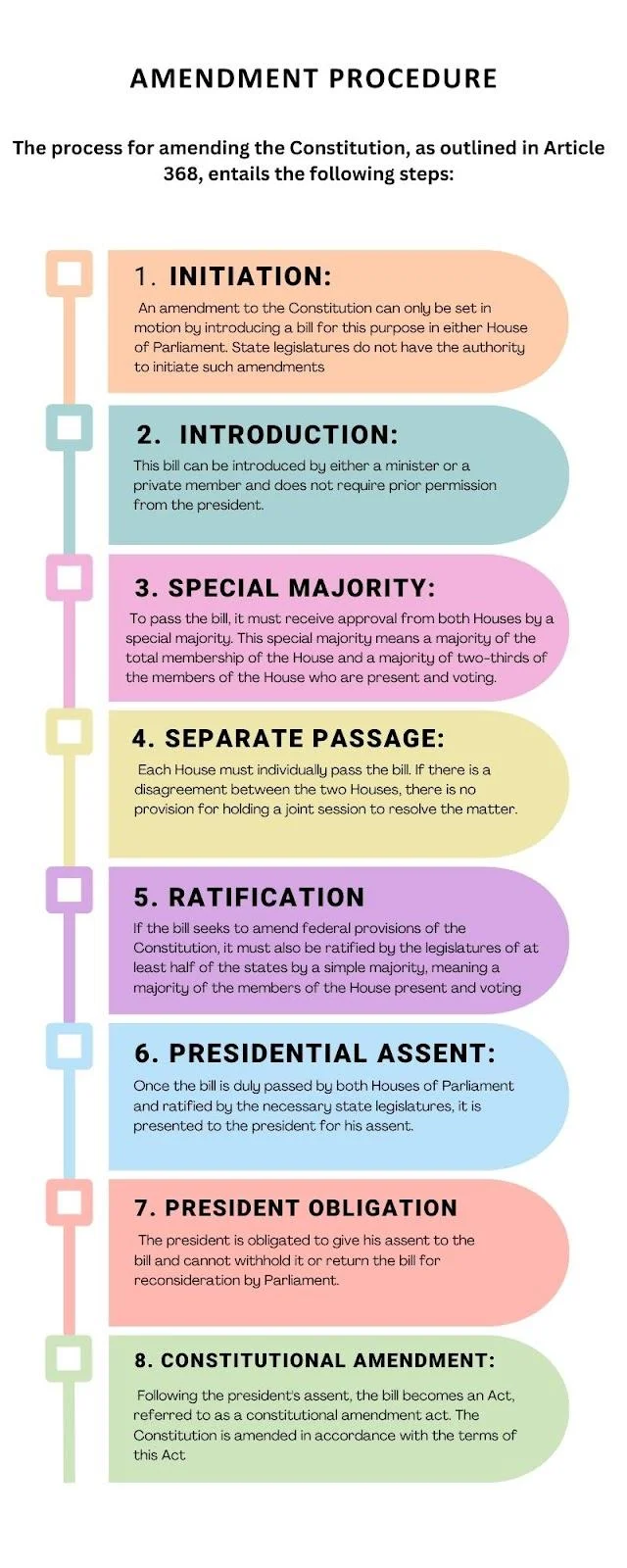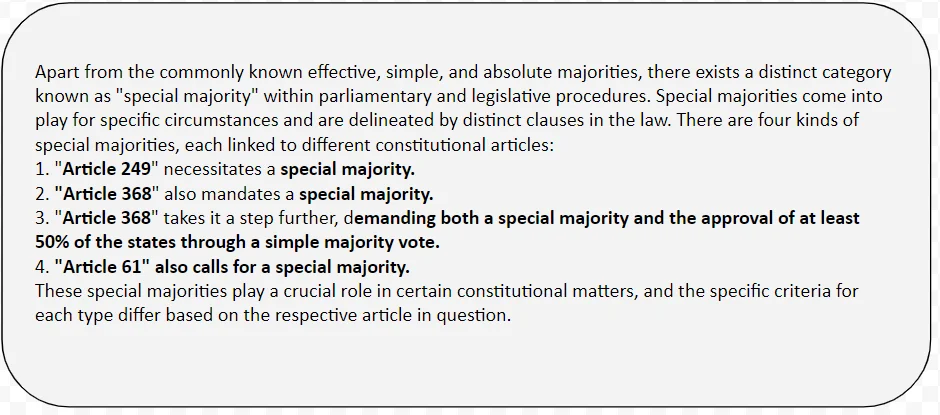The Constitution, derived from the Latin term ‘constituere’ meaning ‘to set up,’ serves as the fundamental framework outlining government operations and citizen interactions. It establishes the principles and laws guiding the governance system. The Indian Constitution is particularly notable for balancing flexibility and rigidity, allowing for amendments to address evolving societal needs while maintaining stability and order.
Overview of Flexibility and Rigidity in the Indian Constitution
The Constitution of India: Definition, Purpose, and the Amendment Process
- Definition and Purpose of a Constitution: In simple terms, a Constitution today refers to a set of rules that outline how a government works and how it interacts with the people in terms of their rights and duties.
- Constitutions are the bedrock of any nation’s governance system, providing a framework of laws and principles that guide the functioning of the state.
- Flexibility in Amendments: Framers of our Constitution felt that Constitutions should take into account both the aspirations of the people and developments in society.
- Vision of the Framers: They did not view the Constitution as an infallible, holy text.
- That’s why they had clauses that allowed for the occasional addition of changes.
- We refer to these modifications as Constitutional Amendments.
- Amending Process Complexity: Indian Constitution’s amending process is neither as simple as it is in Britain nor as complex as it is in the USA.
- Balanced Flexibility and Rigidity: In essence, the Indian Constitution can be described as a harmonious blend of flexibility and rigidity, striking a balance between the two.
- Article 368 in Part XX of the Constitution: It is dedicated to the powers of Parliament concerning the amendment of the Constitution and the procedure for doing so.
- Parliamentary Authority: According to this article, Parliament, in the exercise of its constituent power, has the authority to amend any provision of the Constitution by means of addition, variation, or repeal, following the prescribed procedure.
- Limitations on Amendment Power:It is important to note that there are limitations on this power.
- The Parliament is not allowed to amend those provisions that constitute the ‘basic structure’ of the Constitution.
- This significant restriction was established by the Supreme Court in the landmark Kesavananda Bharati case in 1973.
Enroll now for UPSC Online Course
Types of Constitution
In the world of Constitutional governance, we classify Constitutions as either “rigid” or “flexible.”
- This categorization was introduced by Lord James Bryce.
| Rigid | Flexible |
|
|
Comparison Between Written and Unwritten Constitutions
While written and unwritten Constitutions differ in their form and structure, both types serve as the foundation for governance in their respective countries.
- Key differences between these two Constitutional systems are as follows:-
| Written Constitution | Unwritten Constitution | |
| Meaning | A written Constitutionis one that has been organized, collated, and codified in a systematic and coherent way. | The term “unwritten Constitution” describes a Constitution that has not been formally codified. |
| Evolution | Systematic and step-by-step formulation. | Gradual development over time. |
| Structure | Codified and compiled in a single document. | Collection of laws, customs, conventions, and traditions. |
| Flexibility | Majorly flexible, but can have rigid provisions. | Flexible, adaptable to changing circumstances. |
| Supremacy | The Constitution is supreme. | Parliament or legislature is supreme. |
| Judicial Power | Judiciary ensures Constitutional supremacy. | Limited judicial power. |
| Examples | United States, India, Germany. | United Kingdom, New Zealand, Israel. |
Nature of the Amendment
Pandit Nehru’s Vision for Amendment Flexibility: The amending process envisioned by the framers of our Constitution can be most accurately described by referring to Pandit Nehru’s statement, where he emphasized that the Constitution should not be overly inflexible to the point that it cannot be adjusted to meet the evolving requirements of national progress and resilience.
- Incorporating Flexibility: Elements of flexibility were therefore imported into the Constitution, which is inherently rigid in its nature.
- Promoting Parliamentary Sovereignty: The framers of our Constitution were also driven by the necessity of parliamentary sovereignty, elected through universal adult suffrage, to promote dynamic national progress.
- Simplifying Amendment Procedures: They introduced a more straightforward method for altering provisions of the Constitution that didn’t primarily impact the federal system. This was achieved in two ways:
- Non-Amendment Provisions: By specifying that certain Constitution provisions were “not to be deemed as an amendment of the Constitution.” This means that these provisions can be modified by the Union Parliament through the normal legislative process, requiring a simple majority vote.
- Special Amendment Process: Other provisions of the Constitutioncan be changed only by the process of “ amendment” which is prescribed in the article 368. But a differentiation has been made in the procedure for amendment, according to the nature of the provisions sought to be amended.

Types of Amendments
Methods of Constitutional Amendment: Article 368 outlines two distinct methods for amending the Constitution:
- First: A special majority of Parliament
- Second: Obtaining the ratification of at least half of the states through a simple majority.
- Simple Majority Amendments: However, some other articles within the Constitution allow for amendments by a simple majority of Parliament .
-
- Importantly, these amendments do not fall under the purview of Article 368 for Constitutional amendment purposes.
Understanding Various Majorities in Parliament with Examples
-
- Total Membership (Strength) of the House: 543
- No. of Members resigned/died (and bye-election not yet organized for their seat): 4
- No. of Members disqualified from the House: 3
- Attendance on Two Particular Instances:
| Day | Present | Voting | Abstentions |
| Day 1 | 300 | 270 | 30 |
| Day 2 | 500 | 480 | 20 |
| Type of Majority | Explanation | Minimum Votes needed to Pass the Bill/Motion |
| Simple Majority | Majority of the members present and voting | Day 1: 50% plus 1 of 270 = 136
Day 2: 50% plus 1 of 480 = 241 |
| Absolute Majority | Majority of the total membership of the House | Day 1: 50% plus 1 of 543 = 272
Day 2: 50% plus 1 of 543 =272 |
| Effective Majority | Majority of the effective strength of the House (i.e. Total Strength minus vacancies) | Day 1: 50% plus one of (543-4-3)=269 votes
Day 2: same as Day 1 |
| Special Majority like Article 249 | Majority of not less than 2/3 of the members present and voting | Day 1: 2/3 of 270 = 180 votes
Day 2: 2/3 of 480 = 320 votes |
| Special Majority like Article 368 | Majority of the total membership and by a majority of not less than 2/3 of members present and voting | Day 1: 50% plus 1 of 543 = 272 and 2/3 of 270 = 180 votes So, at least 272.
Day 2: 50% plus 1 of 543 = 272 and 2/3 of 480320 votes So, at least 320. |
| Special Majority like Article 61 | Majority of not less than 2/3 of the total membership | Day 1: 2/3 of 543 = 362 votes
Day 2: Same as Day 1 |

- Special Majority for Presidential Impeachment: In accordance with Article 61 (Procedure for the impeachment of the President) of the Constitution, a special majority is stipulated, necessitating the presence of two-thirds of the total members in a house.
- To elaborate, this translates to 362 members in the Lok Sabha and 164 members in the Rajya Sabha.
Enroll now for UPSC Online Course
-
- These distinct majority requirements differ based on the Constitutional article and play a pivotal role in specific legislative procedures.
| Must Read | |
| Current Affairs | Editorial Analysis |
| Upsc Notes | Upsc Blogs |
| NCERT Notes | Free Main Answer Writing |
Conclusion
The Indian Constitution’s dual nature of flexibility and rigidity ensures it remains a dynamic yet stable foundation for governance.
- Through its structured amendment processes, it accommodates change and promotes progress while preserving the core values of justice, equality, and democracy.
- This balanced approach has allowed the Constitution to evolve alongside the nation’s aspirations and challenges, maintaining its relevance and efficacy over time.
Sign up for the PWOnlyIAS Online Course by Physics Wallah and start your journey to IAS success today!
| Related Articles | |
| Article 368’s Role and the Constitutional Amendment Procedure | Major Constitutional Amendments |
| Supreme Court | Constitution: A Living Document |

 GS Foundation
GS Foundation Optional Course
Optional Course Combo Courses
Combo Courses Degree Program
Degree Program












